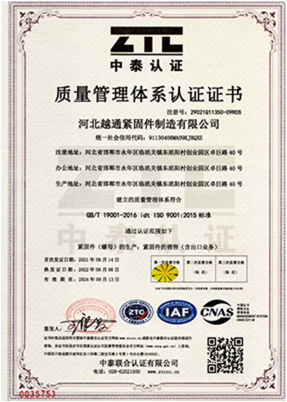Dec . 09, 2024 19:40 Back to list
How to Cut a Threaded Rod Safely and Effectively for Your Projects
Cutting a Threaded Rod A Comprehensive Guide
When it comes to DIY projects, home repairs, or professional fabrication, threaded rods are often a fundamental component. These versatile rods, featuring helical grooves or threads along their length, serve various applications, including acting as a fastener, support for structures, or part of machinery. However, there may be instances where the length of a threaded rod needs to be adjusted, necessitating the skillful act of cutting it. This article will guide you through the process of cutting a threaded rod effectively and safely while ensuring a clean finish.
Tools and Materials Needed
Before starting the cutting process, it’s crucial to gather the necessary tools and materials. You will need
1. Threaded Rod Available in different diameters and lengths. 2. Cutting Tool This can be a hacksaw, an abrasive chop saw, or a band saw. The tool you choose may depend on the thickness of the rod and the finish you require. 3. Measuring Tape To measure the length accurately before cutting. 4. Marking Tool A marker or chalk to clearly indicate where you need to cut. 5. Clamps To hold the rod securely in place while cutting. 6. Safety Gear This includes safety goggles and gloves to protect yourself from metal shards and dust.
Measuring and Marking
The first step in cutting a threaded rod is to measure the length that you need. Using a measuring tape, determine the required length and then mark it on the rod with your marking tool. It’s advisable to double-check your measurements to avoid unnecessary errors, as cutting too short can lead to wasted materials.
Securing the Rod
Once you have marked the cutting point, the next step is to securely clamp the rod. Place the threaded rod in a vice or use C-clamps to hold it steady on a work surface. Properly securing the rod is essential to prevent it from moving while cutting, which can lead to inaccurate cuts and potential injury.
cutting a threaded rod

Cutting the Threaded Rod
Now comes the primary task cutting the rod. Depending on the tool you choose, the technique may vary slightly
1. Using a Hacksaw If you’re using a hacksaw, begin by ensuring that you have a sharp blade suited for metal cutting. Position the blade at the marked line and start cutting with steady, even strokes. Maintain a consistent pressure, and let the blade do the work. Take your time to ensure a clean cut. 2. Using an Abrasive Chop Saw For those who opt for an abrasive chop saw, place the rod securely in the saw’s vice. Align your marked line with the blade, ensure everything is securely in place, and then start the saw. The chop saw delivers a faster and more precise cut compared to a hacksaw.
3. Using a Band Saw If you are using a band saw, similar to the chop saw, position the rod securely, then align it with the blade. Band saws are excellent for achieving clean cuts while minimizing burrs.
Finishing Touches
After cutting the threaded rod, you may notice some rough edges or burrs. To ensure safety and a smooth finish, take a file or deburring tool and carefully smooth out the edges. This not only enhances safety but also improves the aesthetic appeal if the cut ends are visible in your project.
Conclusion
In conclusion, cutting a threaded rod may seem daunting, but with the right tools, careful preparation, and attention to safety, it can be accomplished successfully. Always remember to take your time with measurements and cuts, and don’t hesitate to adjust your approach based on the tools at your disposal and the specific requirements of your project. Whether you are a seasoned professional or a DIY enthusiast, mastering the skill of cutting threaded rods adds a valuable tool to your repertoire, enabling you to tackle various projects with confidence. Happy cutting!


